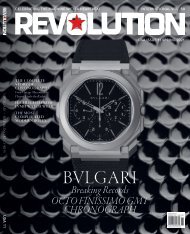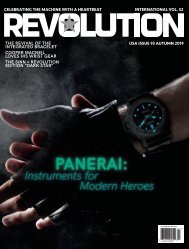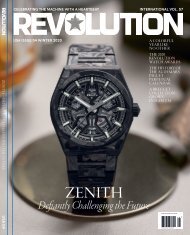Create successful ePaper yourself
Turn your PDF publications into a flip-book with our unique Google optimized e-Paper software.
STRINGS AND THINGS<br />
In 1977 the Day-Date underwent something of a makeover. The<br />
first change was the introduction of a quick-set date change and<br />
the second was the introduction of a sapphire crystal. It was still in<br />
a 36mm case and the metal options were unchanged, but it was an<br />
update none-the-less. The five-digit Day-Date, however, heralded<br />
a new chapter in the gem setting of the watch dials. The “eight plus<br />
two” dials were still used extensively, but this look was supplemented<br />
by a wide range of new styles. Special order watches had always been<br />
available and so there are unique examples from the 1800 series<br />
watches, but the main aim of this piece is to give a general overview of<br />
what was produced in regular production. The exciting thing about<br />
Rolex is that every year new, previously unseen examples surface.<br />
The string dials saw a string of brilliant-cut diamonds set around<br />
the minute track. The hour markers would then be marked with an<br />
additional diamond or in some cases an emerald, ruby or sapphire. In<br />
some rare cases the hours were marked with a single baguette-cut stone.<br />
This page, clockwise<br />
from top left<br />
A Day-Date 18239<br />
“Victory Lap” model<br />
with a ring of brilliantcut<br />
diamonds along<br />
the minute track.<br />
A reference 18039 has<br />
baguette diamonds<br />
for the hour markers<br />
instead of a double<br />
row of brilliantcut<br />
diamonds.<br />
A 18038 “Ruby<br />
Roulette” in yellow<br />
gold, with a selfexplanatory<br />
moniker.<br />
Pavé dials also came into use. One of my favourite iterations is<br />
the paved chapter ring. Essentially this was a precious metal ring<br />
that continued in the same thickness as the day window around the<br />
inner circumference of the dial and it was paved with diamonds. The<br />
chapter ring would be highlighted at the hours with brilliant cut stones,<br />
including diamonds, rubies and sapphires.<br />
The full pavé dial is a Rolex Classic. Who doesn’t love a full dial of<br />
sparkling stones? Still in use today in Rolex sports watches, the full pavé<br />
dial’s maiden voyage was on the Day-Date. Rolex takes gem-setting<br />
very seriously, much like everything else that they do. They only employ<br />
the very best artisans who can flawlessly carry out the work and insist<br />
on the highest possible quality of stones for use on their watches. All the<br />
diamonds used, even the tiniest for full pavé dials, must include zero<br />
inclusions when checked at 10x magnification. Each stone is checked by<br />
eye and compared with master stones to ensure only the finest examples<br />
make it onto watches — Rolex even has its own proprietary tools to<br />
ensure each stone is of uniform shape. The cut used for pavé dials is<br />
known as the 8/8 cut, which has a total of 17 facets.<br />
150 VINTAGE











